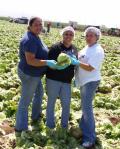|
Voices from the August 8 Glean |
Listen |
|||||
|
|
Another morning of iceberg lettuce, this time just north of Salinas in fields owned by Martin Jefferson & Sons. And real gleaning. The commercial harvesters (some of whom we could see in the field next to ours) had been through this field awhile ago, so it took some real dedication and lots of back-bending and lifting to find fresh heads in a sea of harvest remains. Lots of brown leaves to strip, and we had to be careful to check the cores for rot. But, with help from nearly 100 gleaners, we managed to glean over 8000 pounds of lettuce for the food banks and found plenty to take home ourselves. As always, by glean's end we'd only made a small dent in what was there for the taking. It was a long glean and we talked with a wide range of gleaners, including international students from the Monterey Institute, nursery workers from Driscoll's Strawberries, and church groups as diverse as the LDS Church in Salinas, Carmel Presbyterian, and Our Lady of Angels Youth Group from Burlingame. Here is Part 1 their stories. (For more, see Part 2.) |
[Once the audio is playing, click and drag across the volume bars to change volume. Initial volume set to 80%.] |
||||
|
|
||||||

|
A dozen or so students doing a 4-week course in "Global Trade and Development" at the Monterey Institute of International Studies joined the glean. They came to the program from as far away as Kenya, Viet Name, Malaysia, and India. All came through campuses of the United World Colleges, which encourages "international peace, cooperation, and justice." Because I talked with several of the students and with the program coordinator, I've made a separate page for their stories. |
Read and listen to the stories of these international students. | ||||
|
|
||||||

|
|
|||||
|
The only member of the family who had worked harvesting crops before was Gabriela's 12-year old nephew, Jose. When I asked if he'd worked in the fields before, he said no, but it soon became clear that he meant only that he'd never worked in these huge, commercial fields. He told me about working in the fields of one of the other church members, harvesting many kinds of fruits and vegetables (from onions and lettuce to berries and apricots), sometimes for money but often just to help out. He and his cousin Manuel also go to San Jose to work in the LDS Church welfare system, loading boxes with food to distribute to families in the area. |
||||||
|
|
||||||

|
Pearl Calleros, a retired elementary school teacher and a professional keyboard musician, lives near the fields we were gleaning today. She moved here from the Bay Area with her parents 20 years ago, after she and they sold their houses and bought land here together. Now that she's retired, she's starting to play more jazz. Her father was a saxophone player who had his own big band groups in the Salinas area for many years. Her father also put in his time in the fields as a youngster and told Pearl about working long hours of stoop labor with a short-handled hoe. He also mined quicksilver before going into the military, after which he trained as an aviation mechanic to support the family. Pearl's mother was born in Mexico and picked cotton in the Mexicali area as a young woman. Pearl was gleaning close to the neighboring field where commercial harvesters were loading their conveyor belt, so you can hear the sounds of the tractors and the gusting wind during out conversation. |
|||||
|
|
||||||

|
|
|||||
Here's an excerpt of a conversation I had with Melissa and Ellis on their first glean last October on a muddy, windy day. Surprises? Ellis wasn't expecting to get to wield a knife; Melissa wasn't expecting the sun to come out. Neither expected so many gleaners. |
||||||
|
|
||||||
Note: If you have any trouble using the audio buttons on this webpage, please let us know.
![]()

![]()

![]()

Partially Funded by the California Council for the Humanities, UC Santa Cruz, and INTA - TrainingWeal.

 Photo gallery
Photo gallery